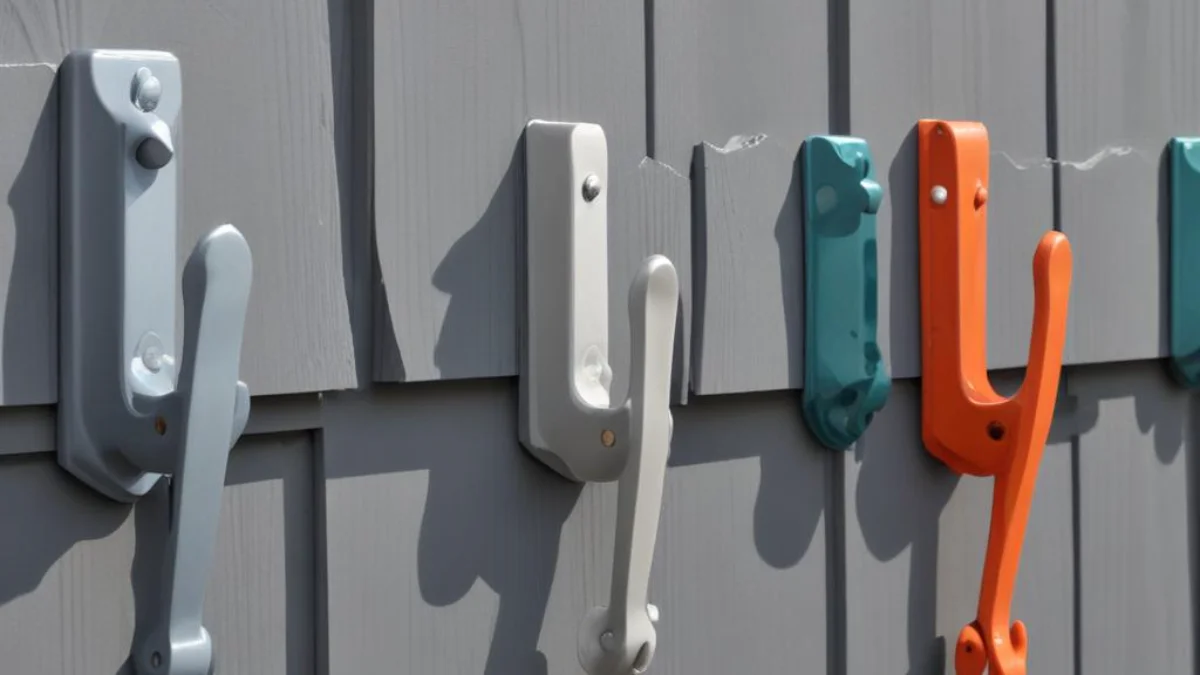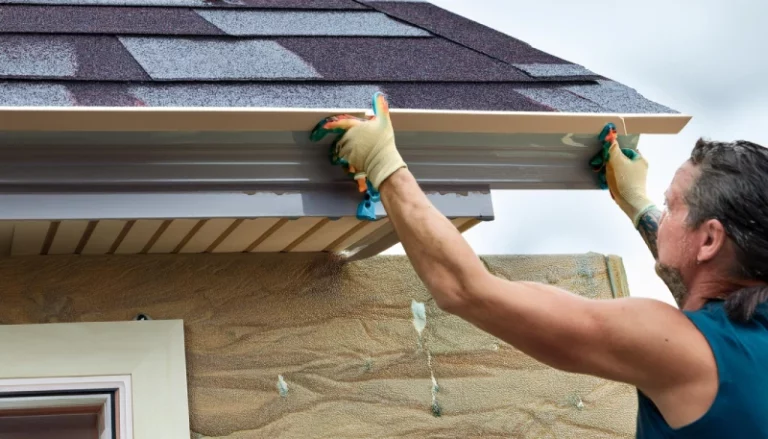How to Hang Things on Vertical Siding Without Regret
Vertical siding offers a unique and modern aesthetic to any home, but it can present a real puzzle when it comes to hanging decorations, lights, or even a simple address plaque. The interlocking panels and distinct orientation can make you hesitate, fearing you’ll cause permanent damage.
Many homeowners are stumped by this challenge. The fear of drilling incorrectly, creating leaks, or voiding their siding warranty is a common and valid concern.
You'll Learn About
Why Is Hanging on Vertical Siding So Tricky?
Unlike traditional horizontal lap siding, where seams provide a convenient lip for hooks, vertical siding presents a smoother, more uniform surface. The main challenge lies in finding a secure anchor point without compromising the siding’s integrity and weather-resistant properties.
Drilling holes incorrectly can allow water to seep behind the panels. This moisture intrusion can lead to mold, rot, and significant structural damage over time, turning a simple decorating project into a costly repair. This is especially critical to consider in areas prone to drainage issues, which can be as problematic as improperly managed gutter downspouts on a patio.
The Anatomy of Vertical Siding
Vertical siding, whether it’s vinyl, fiber cement, or wood, consists of panels installed over a sheathing and weather barrier. The key is the small gap or seam between the panels. This seam is the secret to damage-free hanging for lighter objects.
For heavier items, you can’t rely on the siding itself for support. The siding is a protective skin, not the structural frame of your house. You must anchor heavy objects directly to the wall studs located behind the siding.
The Damage-Free Solution: Siding Hooks
For lightweight decorations like holiday lights, wreaths, thermometers, and small signs, the absolute best solution is to use vinyl siding hooks. These small but mighty gadgets are designed specifically to work with the construction of your siding, eliminating the need for any tools or holes.
These hooks are typically made of stainless steel for durability and rust resistance. They feature a curved top that cleverly slips into the seam between two vertical siding panels. The hook then provides a secure point from which to hang your items.

How to Use Vertical Siding Hooks
Using these hooks is incredibly simple. Gently pry the seam between two panels apart just enough to slide the curved end of the hook into the gap. Once inserted, the hook will click into place, held securely by the tension of the siding panels.
Most standard siding hooks are designed for horizontal siding, so it is crucial to purchase hooks specifically made for vertical siding. These often have a slightly different design to ensure a secure fit. Always check the weight limit of the hooks before hanging your items.
Hanging Heavier Items: The Right Way to Drill
When you need to hang something substantial, like a hose reel, a large address plaque, or heavy-duty shelving, siding hooks won’t suffice. In these cases, you must anchor the item to the wall studs for safety and stability. This does involve drilling, but there’s a right way to do it that minimizes risk.
The goal is to create a secure, weather-tight installation. This involves locating the studs, using the correct mounting hardware, and properly sealing the area to prevent water intrusion.
Step 1: Locate the Studs
First, you need to find the studs behind the siding. A high-quality electronic stud finder is the most reliable tool for this job. Most studs are spaced 16 or 24 inches on center. Mark the location of the studs with a pencil or a piece of painter’s tape.
Do not assume you know where the studs are. Taking the time to locate them precisely is the most critical step for a secure installation.
Step 2: Use a Mounting Block
Never mount a heavy fixture directly onto the surface of the vertical siding. The siding can crush or warp under the pressure. Instead, use a vinyl siding mounting block.
A mounting block provides a flat, stable surface for your fixture and is designed to integrate seamlessly with your siding. For vertical siding, you’ll need a specific type of mounting block that can be installed over the existing panels. Some advanced systems, much like the precision needed for a Kohler LuxStone shower installation, require a professional touch for a perfect fit.
Step 3: Drill and Seal
Once you’ve positioned your mounting block over the located studs, drill pilot holes through the block and the siding. Be careful not to apply excessive pressure that could crack the siding.
Before inserting your screws, apply a generous amount of high-quality exterior caulk or sealant around the holes. As you drive the screws in, the sealant will create a waterproof gasket, protecting the underlying structure from moisture. This is a non-negotiable step for preventing long-term damage.
Comparing Hanging Methods
Choosing the right method depends entirely on what you’re hanging. Here is a breakdown of the best options for different items.
| Hanging Method | Best For | Pros | Cons |
|---|---|---|---|
| Vertical Siding Hooks | Lights, wreaths, small signs, thermometers (under 5 lbs) | No damage, easy to install/remove, reusable, affordable | Low weight capacity, not suitable for heavy items |
| Adhesive Hooks | Very lightweight items on smooth siding (e.g., vinyl) | No drilling, simple application | Can fail in extreme temperatures, may leave residue, very low weight limit |
| Screws with Mounting Block | Hose reels, large plaques, shelves, security cameras (over 5 lbs) | Extremely secure, supports heavy loads, professional finish | Requires drilling, more complex installation, permanent |
| Drilling Directly (Not Recommended) | N/A | None | High risk of water damage, can crack siding, may void warranty |
Common Mistakes to Avoid
When tackling this project, a few common mistakes can lead to big headaches. Avoiding them is key to a successful and damage-free installation.
The most frequent error is using screws that are too short. Your screws must be long enough to pass through the mounting block, the siding, the sheathing, and penetrate at least 1.5 inches into the wall stud. Short screws will only anchor to the siding itself, which is not secure.
Ignoring the Need for Sealant
Another critical mistake is skipping the exterior sealant. Any hole you create in your home’s exterior envelope is a potential entry point for water. Always use a high-quality, weatherproof silicone caulk to seal around any screws or penetrations.
Think of it as cheap insurance against very expensive repairs down the road. It’s a simple step that ensures the longevity of both your siding and your home’s structure. Similarly, using the wrong materials in other home projects, like putting play sand in a gas fireplace, can lead to unforeseen consequences.
Final Thoughts: Hang with Confidence
Hanging items on your vertical siding doesn’t have to be intimidating. By understanding the structure of your walls and choosing the right method for the job, you can decorate and accessorize your home’s exterior with confidence.
For lightweight items, always opt for the simple, brilliant solution of no-drill vertical siding hooks. For heavier installations, take the time to do it right with a proper mounting block, stud anchoring, and weatherproof sealant. Your home will look great, and you’ll have peace of mind knowing you did it the safe and correct way.
Frequently Asked Questions
What is the best way to hang light items on vertical siding without drilling holes?
For lightweight decorations, vinyl siding hooks are an excellent option that won’t damage your siding. These hooks are designed to slip into the seam between siding panels, providing a secure place to hang items without the need for any holes. Be sure to choose stainless steel hooks to avoid rust and staining on your siding.
Can I drill into my vertical siding to hang heavier objects?
Yes, it is possible to drill into vertical siding, but it’s crucial to drill into a stud or framing behind the siding for adequate support. Simply drilling into the siding itself is not enough to hold heavy items and can cause damage. Always use a stud finder to locate the framing before drilling and be sure to seal any holes afterward to prevent moisture intrusion.
How much weight can I hang on vertical siding?
The amount of weight siding can support depends on the hanging method. Vinyl siding hooks are typically intended for lighter items, often up to 5-12 pounds. For heavier objects, you will need to anchor them with screws or fasteners directly into the wall studs behind the siding, as the siding itself is not designed to bear significant weight.
Are there special hooks for vertical vinyl siding?
Yes, there are hooks specifically designed for vinyl siding that can be used on vertical applications. These “no-hole” hooks work by clipping into the seams of the siding panels, providing a secure point for hanging without causing any damage. They are easy to install, remove, and relocate as needed.
How can I hang things on board and batten siding?
Hanging items on board and batten siding presents a unique challenge due to its vertical panel design. For lighter decorations, vinyl siding hooks or no-hole hooks that fit into the seams are a good solution. For heavier items, you will need to drill through the siding and into the solid wall structure behind it, using appropriate screws or fasteners for a secure hold.

